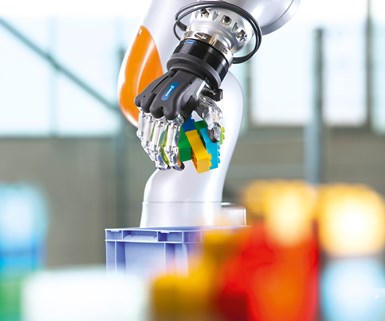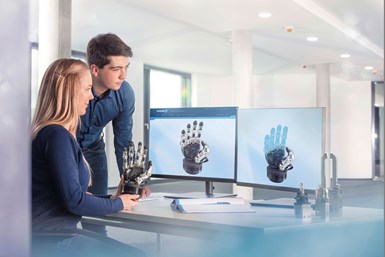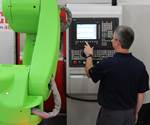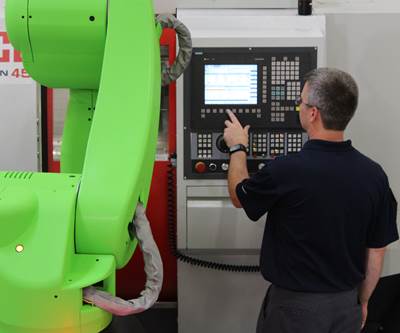A Hands-On Approach to Cobot Gripping
As humans and robots begin to work closer together, grippers that have the flexibility of the human hand will be more in demand.

Gripping hands are ideal for environments or activities that are configured for humans, such as industrial assembly workstations, or picking and logistics applications. Photos provided by Schunk.
When it comes to flexibility in gripping tools, experts still regard the human hand as the benchmark. Humanoid manipulators that enable the widest variety of gripping variants will be more and more in demand in the future, particularly when it comes to service and assistance robotics. However, the factor of economic viability is also increasingly important.
Grippers that are designed for industrial automation are typically based on robustness, longevity and performance, while gripping hands focus on flexibility of motion. The relevance of these humanoid, five-fingered hands will grow as humans and robots begin to work closer together. "In extreme cases, human beings and service robots will share one and the same workstation, including all tools and auxiliary equipment," explains Dr. Martin May, head of research/advanced technologies at Schunk. For this reason, Schunk had its SVH five-finger hand gripper certified in 2017 by the German Social Accident Insurance (DGUV) as the world’s first gripper for collaborative operation. The gripper’s five fingers can carry out many kinds of gripping operations with the help of a total of nine drives. Further, numerous gestures can be performed, facilitating visual communication between humans and the service robot and increasing acceptance for its use in human environments.
Sharing a Desk with a Robot
"In our research projects, we were able to ascertain that the human hand is much more than just a highly flexible tool for handling. Unlike with industrial grippers, users always associate emotional aspects with humanoid gripping hands," Dr. May says. "Gripping hands are always in demand wherever a robot has to imitate human handling methods." This involves both manipulation and gestures. In its research projects, Schunk has focused in particular on domestic-type applications of service robotics and assembly-oriented applications in industrial assistance robotics. "Gripping hands are a sensible option wherever the environment of an activity is configured for human beings, who are then to be assisted by a robot, for example in domestic kitchens but also in industrial assembly workstations or in picking and logistics applications," adds Dr. May.
Different Variants of Gripping Hands

Five-fingered robot grippers with the flexibility of human hands will be more in demand as humans and robots begin working closer together, enabling them to share workstations and tools.
Schunk has various gripping hands in its portfolio to handle a range of applications, including a two-fingered hand reduced to the basic functions of gripping for service robotics, the Schunk SDH industry-compliant three-fingered hand and the complex Schunk SVH five-fingered hand. The company’s latest model, the SIH, is likewise equipped with five fingers structured similar to human beings, but it differs from the SVH fundamentally in terms of drive and kinematics. Whereas the SVH, which is driven via nine motors, complies with the typical aspects of a precision working robot hand, the SIH, which is equipped with five motors and actuated via pull cables, is designed to be closer to its human counterpart with its veins and muscles. Three of its fingers can be moved independently of one another, and the two smallest move together as a team. As a result, the SIH is designed to be deployed more flexibly than other gripping hands with pull cable mechanisms, while being more robust and lower in price. According to Dr. May, this latter aspect in particular was a key requirement for the research project, because strict management of costs is essential for successful service robotic applications in domestic environments. In order to attain the goal of affordable, simple-to-operate five-fingered hands for versatile applications, Schunk uses experience from bionics as well as the latest motor and electronics concepts. Using intelligent gripper control, a wide range of gripping projects can be realized via a simple-to-operate interface without the need for precise programming.
Autonomous Gripping
In its Smart Labs, Schunk goes a step further—it is dedicated to the gripping process as a whole and is looking for ways of handling tasks autonomously. In the future, intricate robotic programming, which until now had to be done manually by the user or integrator, will be replace by a learning, autonomous assembly of components.
Instead of individually defining positions, speeds, and gripping forces step-by-step, intelligent gripping systems of the future will detect target objects via cameras and plan gripping of its own accord. Gripping systems will be capable of detecting principles and deriving corresponding actions based on data records and algorithms. In addition, Schunk R&D is working on algorithms for classifying different geometries and arrangements and developing optimum gripping strategies. Gripping systems should be able to handle parts autonomously and refine the underlying gripping workflows ever further.

Schunk has several gripping hands available for a range of applications. The company’s latest model, the SIH, is designed to be a flexible, robust and low-cost five-fingered gripper.
Autonomous Evaluation of Gripping Quality
Gripping hands will be deployed sooner in applications with greater variances in parts to be gripped and more complex tasks. The quality of a grip can be detected, evaluated, and readjusted if necessary by means of corresponding sensor systems in the gripper fingers, the motor current, and intelligence integrated in the gripping hand. The grippers can also sense certain characteristics of objects, like geometry, size or flexibility, and transfer this information to higher-level systems or upstream/downstream stations. "Using artificial intelligence methods, it will also be possible to train service and assistance robots intuitively and create individual libraries for gripper planning and then add to these," explains Dr. May. "Particularly gripping hands for versatile use will then no longer be deployed for repetitive tasks but it will be possible for them to be continually adapted to new objects and relations and their gripping strategies optimized on an ongoing basis."
Schunk | 800-772-4865 | schunk.com
Related Content
Chuck Jaws Achieve 77% Weight Reduction Through 3D Printing
Alpha Precision Group (APG) has developed an innovative workholding design for faster spindle speeds through sinter-based additive manufacturing.
Read MoreUnattended Production Takes More Than the Most Capable CNC Machine
Process planning and reliable peripherals are key to successful lights-out manufacturing.
Read MoreStarting Small with Automation
Quick-change workholding and flexible robotic automation started this small shop on the path to success.
Read MoreZoller Event Shines Lights on Shopfloor Connectivity
The company’s open house event highlighted smart manufacturing solutions from CAM to part.
Read MoreRead Next
Automation in High-Mix, Low-Volume Turning Applications
Turning shops are familiar with automation for high-volume work, but the shifting landscape to smaller batch sizes has created new challenges.
Read MoreImproper Cobot Integration Can Cost $86,000 per Shift Operation
Cobots can improve efficiency, innovation and growth, but companies that buy them without well-defined objectives could be wasting a lot of money.
Read MoreDeveloping a Company Plan for Robotics
It’s a good time for shops to re-evaluate the impact robotic automation can have on productivity.
Read More








.jpg;maxWidth=300;quality=90)













